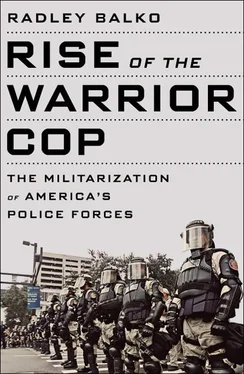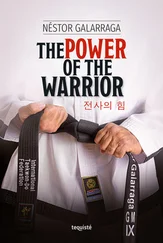I attempted to contact Johnson to ask if he’d like to clarify his comments. He didn’t return my calls. As they stand, these quotes are striking, particularly from someone who once worked for the Department of Homeland Security and now runs a consulting firm that works with law enforcement agencies. They certainly appear to dismiss police militarization—a phenomenon documented by a wide range of media outlets and criticized by interests all across the political spectrum—as merely a fantasy cooked up by extremists to boost their recruiting. Incidentally, the publications and advocacy groups who have recently expressed concerns about police militarization include ThinkProgress, Wired, Salon, MSNBC, and Democracy Now —all of them also ran articles praising Johnson.
So long as partisans are only willing to speak out against aggressive, militarized police tactics when they’re used against their own and are dismissive or even supportive of such tactics when used against those whose politics they dislike, it seems unlikely that the country will achieve enough of a political consensus to begin to slow down the trend.

JUST AS WITH BILL CLINTON, THERE WAS HOPE AMONG progressives that Barack Obama would take a more conciliatory, less militaristic approach to the drug war. And just as with Bill Clinton, Obama has come up short. According to a tally by Current TV, by the end of his first term, Obama had overseen more federal raids on medical marijuana dispensaries in four years than George W. Bush had presided over in eight. Obama also stepped up immigration raids and continued the raids on doctors and pain clinics suspected of overprescribing opioids. He continued to encourage Mexico’s policy (aided by US foreign aid and weapons) of fighting its drug war with the military, despite the horrifying carnage caused by that policy. And as previously discussed, Obama and Democratic leaders in Congress re-funded the Byrne grant and COPS programs that contributed to the rise in SWAT teams and multi-jurisdictional antidrug and anti-gang task forces—and at record levels.
The 1033 program has also soared to new heights under Obama. In its October 2011 newsletter—which carries the revealing tagline “From Warfighter to Crimefighter”—the Law Enforcement Support Office (LESO), the agency that oversees the Pentagon giveaways, boasted that fiscal year 2011 was the most productive in its history—by a lot. “FY 11 has been a historic year for the program,” wrote LESO program manager Craig Barrett. “We reutilized more than $500M, that is million with an M, worth of property in FY 11. This passes the previous mark by several hundred million dollars…. Half a billion dollars in reutilization was a monumental achievement in FY 11 but I believe we can exceed that in FY 12.” 96
The take in 2011 alone was equivalent to about 18 percent of the total value of the equipment the program had given away in its history. In fiscal year 2011, the program gave away eight hundred Humvees, a 700 percent increase over 2010. In Los Angeles County, the sheriff’s department put four semi-trailers on standby so that as a new piece of desirable war gear became available, the department could be en route to pick it up before another police department could claim it. The investigative journalism site California Watch reported that by 2011 the department was taking in $3 to 4 million worth of military gear annually, including “M16 rifles, helicopters, microwaves, survival kits, workout equipment, bayonet knives, [and] ammunition cans.” During the record year for 1033 in the state as a whole, California police agencies raked in over 163,000 total items in 2011 worth over $26 million, “from bath mats acquired by the sheriff of Sonoma County to a full-tracked tank for rural San Joaquin County.” Police in San Joaquin County had already purchased a $500,000 armored “mobile command center” with a DHS grant. California Watch reported that in “Rio Dell—a small Humboldt County town with just four full-time officers, not including the chief—the police department has used the program to pick up two vehicles [and] two M-16 rifles.” 97
In Richland County, South Carolina, Sheriff Leon Lott was so pleased with his new acquisition that he posed with it, along with his SWAT team, and then put out a press release. He called it “The Peacemaker,” explaining in his release that “the Bible refers to law enforcement in Matthew 5:9, ‘Blessed are the peacemakers: for they shall be called the children of God.’” The “Peacemaker” is an M113A1 armored personnel carrier. The vehicle moves on tanklike tracks and features a belt-fed, turreted machine gun that fires .50-caliber rounds. Richland County includes the city of Columbia and its northern suburbs. It’s also home to the University of South Carolina. What it isn’t is a battlefield.
According to Charles Earl Barnett, a US Marine veteran and retired police major who has served on several United Nations and NATO military and peacekeeping missions, a .50-caliber machine gun is “completely inappropriate” for domestic police work. It “causes mass death and destruction,” Barnett told me in 2008. “It’s indiscriminate. I can’t think of a possible scenario where it would be appropriate.” 98
But Richland County isn’t the only jurisdiction that can fire off rounds of that size. Sheriff Joe Arpaio in Maricopa County, Arizona, also has a gun that shoots .50-caliber ammunition. So does Chattanooga, Tennessee; Anne Arundel County, Maryland; and Cuyahoga County, Ohio. In Bossier Parish, Louisiana, the .50-caliber gun is mounted to an armored vehicle that the sheriff calls his “war wagon.” At least after the sheriff’s department in Faulkner County, Arkansas, used nearly $12,000 in asset forfeiture funds to purchase a .50-caliber gun, they had the good sense to decide they shouldn’t use it. “It shoots through buildings,” Sheriff Karl Byrd told a local newspaper. “There is absolutely no legitimate law enforcement use of this rifle.” 99
There have been at least a few other voices of sanity. In Massachusetts, Gov. Deval Patrick ordered the state’s police agencies to stop using the program pending an investigation, after a Boston Globe report found—well, basically what similar investigations all over the country had found. From the Globe:
Police in Wellfleet, a community known for stunning beaches and succulent oysters, scored three military assault rifles. At Salem State College, where recent police calls have included false fire alarms and a goat roaming the campus, school police got two M-16s. In West Springfield, police acquired even more powerful weaponry: two military-issue M-79 grenade launchers. 100
In June 2012, the Pentagon suspended the entire 1033 program—not because of any concern about the militarization of civilian policing, but because of recent press reports of mismanagement by some of the participating law enforcement agencies. An Arizona Republic investigation had found that the Pinal County sheriff’s department transferred some of the Pentagon equipment to nonpolice agencies, and was planning to sell some other equipment at auction. A broader AP report found that police departments had kept poor records about their use of the equipment obtained through the program, including high-powered weapons that could no longer be accounted for. As of November 2012, however, the program was back up and running.
Finally, the Obama administration has continued to defend in court the use of military-like violence to enforce the drug laws. In Avina v. US, DEA agents pointed their guns at an eleven-year-old and a fourteen-year-old during a mistaken drug raid. The agents had apparently misidentified the license plate of a suspected drug trafficker for the plate on a car owned by Thomas Avina, the father of the children. The Obama administration argued in federal court that the lawsuit should be dismissed before even being heard by a jury—that the agents’ actions were reasonable under the Fourth Amendment. Of course, it’s not at all unusual for an administration to defend the actions of federal drug agents. But this was an administration whose drug czar had suggested that perhaps it was time to tone down the battle rhetoric that government officials often used when enforcing the drug laws. He was right about that. But on the front lines, the administration was arguing in court that there’s nothing unreasonable about government agents pointing guns at the heads of children whose parents are suspected of drug crimes—and that even when said gun-pointing is done in the service of a mistaken raid, the agents should be shielded from any liability. 101
Читать дальше













